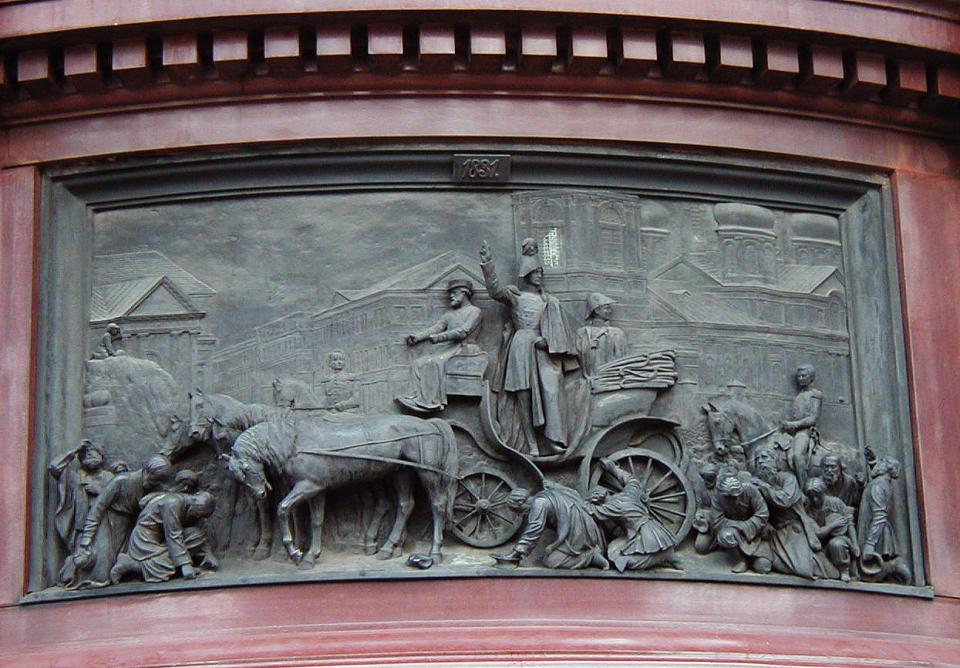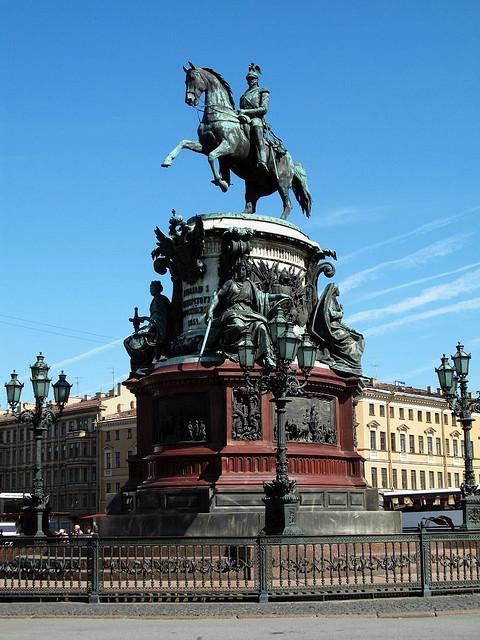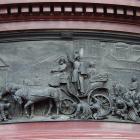Cholera came to Russia in the nineteenth century as part of a global pandemic that had originated in India. In 1831, St. Petersburg was struck by its first major cholera epidemic. The disease was able to develop rapidly largely due to the city’s immense water pollution problem. Sewage was dumped into the rivers and channels; at the same time, citizens also used the untreated water of the Neva River as drinking water. However, water was not known to be the cause of the disease, and soon the ordinary population started to blame doctors, the gentry, officials, and foreigners for the spreading epidemics.

Detail from Nicholas I monument: Czar Nicholas I makes the protesters kneel and take off their hats (1859)
Detail from Nicholas I monument: Czar Nicholas I makes the protesters kneel and take off their hats (1859)
2010 Alexei Kraikovski
Click here to view Wikimedia source.
 This work is licensed under a Creative Commons Attribution-NonCommercial-ShareAlike 3.0 Unported License.
This work is licensed under a Creative Commons Attribution-NonCommercial-ShareAlike 3.0 Unported License.
On June 22, 1831, a crowd of the common people gathered together for protest at Sennaya square in the center of St. Petersburg. They protested against the governmental measures against cholera epidemics, such as quarantines and cordons, which they considered a plot of the educated classes to repress the poor.

Monument of Czar Nicolas I at St. Isaac square in St. Petersburg (1859)
Monument of Czar Nicolas I at St. Isaac square in St. Petersburg (1859)
2006 Victor Radziun
Click here to view Flickr source.
 This work is licensed under a Creative Commons Attribution-NonCommercial-ShareAlike 3.0 Unported License.
This work is licensed under a Creative Commons Attribution-NonCommercial-ShareAlike 3.0 Unported License.
As protest turned into a riot, the inflamed crowd started to sack the city’s main cholera hospital, beat the market sanitary inspectors, whom they accused of having spread the disease, and called for the death of all doctors in the city, whom they blamed for having poisoned the poor’s wells. The administration was forced to send in military troops. However, the riot was only halted when Czar Nicholas I appeared in the market square and ordered the crowd to fall on their knees and take their hats off in deference to him. Nicholas would later consider the suppression of the cholera riot to be one of the most important episodes of his life.
Although the riots were stopped, the real problems, such as the need to improve the quality of drinking water in St. Petersburg, were not addressed. Throughout the nineteenth and early twentieth centuries cholera continued to be one of the biggest problems for the city.
How to cite
Kraikovski, Alexei. “The St. Petersburg Cholera Riot of 1831: Water Pollution and Social Tension.” Environment & Society Portal, Arcadia (2013), no. 9. Rachel Carson Center for Environment and Society. https://doi.org/10.5282/rcc/5299.
ISSN 2199-3408
Environment & Society Portal, Arcadia
 This work is licensed under a Creative Commons Attribution-NonCommercial-ShareAlike 3.0 Unported License.
This work is licensed under a Creative Commons Attribution-NonCommercial-ShareAlike 3.0 Unported License.
2013 Alexei Kraikovski
This refers only to the text and does not include any image rights.
Please click on the images to view their individual rights status.
- Gessen, Sergey Yakovlevich. Kholernye bunty 1830–1832. Moscow: Izdatel'stvo Vsesoyuznogo obshchestva politkatorzhan i ssyl'no-poselentsev, 1932.
- Kraikovski, Alexei V., and Julia A. Lajus. “The Neva as a Metropolitan River of Russia: Environment, Economy and Culture.” In A History of Water. Series 2, Volume 2. Rivers and Society: From Early Civilizations to Modern Times, edited by Terje Tvedt, Terje Oestigaard, Richard Coopey, Graham Chapman, and Roar Hagen, 339–64. New York: I. B. Tauris, 2010.
- McGrew, Roderic E. Russia and the Cholera, 1823–1832. Madison: University of Wisconsin Press, 1965.








